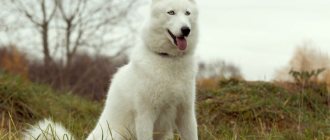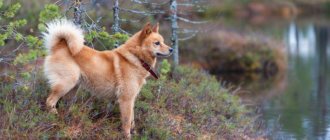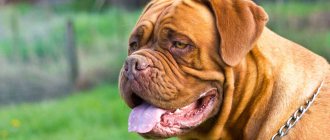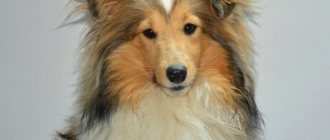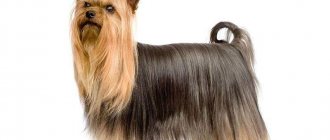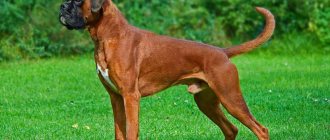Podenco Ibizanco or Ibizan Greyhounds are slender, fine-boned dogs with large, mobile ears and a noble look of slanted amber eyes. Thanks to their excellent eyesight, phenomenal hearing and keen sense of smell, they have earned a reputation as excellent hunters and are still used for their intended purpose.
Let's find out what Ibicenco Podencos are and what the specifics of keeping the breed are.
brief information
- Country of origin: Spain (Balearic Islands, Ibiza Island).
- Other names: Ibizan or Ibiza Greyhound, Galgo Greyhound, Ibizan, Balearic Italian Greyhound, Ibizan Hound.
- According to FCI: group 5 – Spitz and primitive dogs. Standard No. 89 dated February 4, 2000.
- Purpose: unarmed pack hunting, search, companion.
- Basic color: white, red, variations of a combination of these two colors.
- Life expectancy: 12 – 15 years.
- Average weight: males up to 25 kg, females up to 21 kg.
- Height: males 62-70 cm, females 58-66 cm.
- Average cost: $1,000.
Photo: wikimedia.org
Characteristics of Cirneco del Etna dogs: features of the Sicilian greyhound breed
The Cirneco dell'Etna dog breed has lived on the island of Sicily for more than 2,500 years. Its other name is the Sicilian Greyhound. Due to its physiological characteristics, it is used for hunting hares and rabbits. Little is known about this breed outside the island, but in recent years in Russia there have been more and more people interested in such pets.
History of the breed
The Sicilian Greyhound is considered one of the most ancient breeds, it has much in common with other Mediterranean canines, for example, the Podenco Canario, the Ibicenco Podenco or the Pharaoh Hound from Malta.
Sicilian Greyhound
Most linguists believe that "cirneko" comes from the Greek word "Kyrenaikos", which was the name of the ancient Syrian city. That is why there is an opinion that the breed comes from the Middle East, and was already brought to Sicily by Greek merchants from North Africa.
Note! The results of numerous genetic studies have shown that the Pharaoh Hound has virtually nothing in common with the greyhound
Cirneco del Etna: description of the breed and character
Greyhound (dog): description of the English greyhound breed
Other common names for the breed are Sicilian Greyhound, Sicilian Greyhound, Cirneco dell'Etna and Sicilian Hound.
Difficulties in care and maintenance: animals do not tolerate low temperatures and especially dampness; pets must be insulated for the winter.
You should also carefully monitor the condition of your pet’s claws and trim them properly in a timely manner.
Cirneco white color
Brief characteristics of the breed:
- Height ranges from 46 to 50 cm.
- Life expectancy under good conditions ranges from 12-15 years.
- Weight 10-12 kg.
- The breed is short-haired, no more than 3 cm long, smooth and fits tightly to the skin.
- The color is even, rich red. White and white with red tan colors are also acceptable in the breed. All shades of ocher and fawn are also allowed.
Pets of this breed have an independent and strong character. Despite this, they easily make contact with people and other animals and are very attached to their owners. An important factor when choosing a pet for the family is that the greyhound has a stable psyche and gets along well with children. This dog is exclusively domestic, despite his activity and need for games.
Note! Cirneco del Etna are not prone to loud barking and fuss. Despite their small size, they are not decorative breeds
Hygiene and care
Russian greyhound dog: description of the hound breed
The pet is unpretentious in care and maintenance.
The pet is smooth-haired, so brushing it with a special brush with stiff bristles is sufficient no more than once a week. The animals are clean and therefore do not have an unpleasant odor.
They should be bathed rarely. For example, pets that take part in various exhibitions are bathed no more than once a month.
The animal's ears require close attention.
It is important for dogs to clean their ears regularly, as secretions that accumulate in them can cause inflammation of the middle ear. You also need to trim your nails regularly.
Who is the Sicilian dog suitable for?
The Sicilian Greyhound is suitable for apartment living
But it is important that the owner leads an active lifestyle. As practice shows, the breed is ideal for athletes and hunters
The pet should not be left alone at home for an extended period of time.
Sicilian greyhound puppy
Note! The dog is friendly, but with the appearance of children in the house, you should not count on its 100% obedience. Pets often become jealous, so breeders recommend holding off on purchasing a dog until your children are older.
In an apartment, the animal gets along with other pets, but on the street at any convenient time it can chase another dog or cat.
How much does it cost and where can I buy it?
Dogs do not tolerate cold well, so they are not very common in Russia. However, in Moscow there is a National Breed Club where you can purchase a purebred puppy. The price of a dog ranges from 50-70 thousand rubles.
Sicilian greyhound mother
History of the origin of the breed
The most famous and popular version of the origin of the Podenco ibicenco breed is from the ancient dogs of Egypt, who lived for almost 3 thousand years at the court of the famous Tutankhamun. Their images can be found on the walls of burial pyramids and any household items. Beloved by modern cinema, Anubis, the god of death, is visually almost identical to the Podenco Ibicenco.
Dogs came to Europe in the 8th century BC, arriving there with Phoenician sailors, who chose modern Ibiza as a refuge. Then the dogs spread to nearby territories, as the Podencos showed miracles of skill in hunting rabbits.
Harsh hunting conditions at any time of the day and the isolation of the distribution area helped to develop the unique properties of the Ibicenco Podenco.
Alternative version: Ibizans formed as a breed relatively recently, by crossing several similar breeds. They look like ancient Egyptian dogs only in appearance, they are not descendants.
1963 was the year the breed standard was formed; from that time on, the dogs were called “Pharaoh Hound.” In 1977, another type of greyhound dog received the same name, and confusion began. In 1982, the standard was revised, the name of the breed was changed to Podenco Ibicenco.
Photo: wikimedia.org
Purpose
From the very beginning of its history in ancient Egypt, the Podenco Ibicenco was a hunting dog. Basically, its prey is small game such as fox, hare or bird, very rarely - wild boar, deer or wolf. Among the physical advantages, in addition to an excellent sense of smell, excellent eyesight stands out. The dog sees not only during the day, but also at night, which is a unique feature among all greyhounds.
Another useful skill for hunting is the ability to work in a team. Moreover, when driving prey, one individual attacks, and the rest stand in support, ready to help if necessary. Now, as at the beginning of its history, the Ibicenco Podenco is used as a hunting dog; it is especially popular in this regard in Spain. In addition, it is used in coursing and greyhound racing, and of course, as a show dog and personal companion.
Description of the breed
The natural qualities of Ibizan hounds: an excellent sense of smell, excellent vision at any time of the day allow them to be involved in hunting without using weapons. These dogs hunt in packs and do everything on their own, notifying humans about the results of the work done.
Currently, the breed is used as a companion in sports competitions (running, coursing, agility, etc.).
Standard
- important proportions: body length must exceed height at the withers;
- skeleton: refined, lean;
- muscles: elastic, flat, not massive;
- the head has the shape of a truncated cone, very dry;
- eyes: slanted, amber in color, small;
- ears: large in relation to the head, well defined, not cropped;
- the lengths of the muzzle and skull are equal;
- nose: large lobe, in harmony with the color of the dog (flesh color). May be partially pigmented;
- bite: “scissors” incisors in one line, teeth white and strong;
- body: thin neck, prominent ribs, deep chest with sharp bones, sloping croup;
- tail: low set;
- limbs: dry, lean, long and muscular;
- coat: short-haired and long-haired (3-7 cm);
- movements: light, “footprint”.
Disadvantages and disqualifying vices
- black pigment in color;
- hanging ears;
- shortened, widened head;
- barrel-shaped chest;
- defects in the structure of the limbs (inverted forelimbs, etc.);
- dental defects (lack of molars, underbite, overshot, etc.);
- poor orientation in movement, awkwardness;
- aggression, cowardice.
Photo: wikimedia.org
Appearance
Podenco Ibicenco is a long-legged, strong greyhound, but not heavy. Slightly elongated, dry body type, with large erect ears and a long muzzle. Sexual dimorphism is moderately expressed. Males are somewhat larger and stronger than females. Height at withers 60-72 cm, weight 19-25 kg.
The head is long, thin, dry. Small in relation to the body. The skull is flat and long with a prominent occipital part. The forehead is flat. The stop is weakly expressed. The muzzle is long, the distance from the tip of the nose to the eyes is equal to the distance from the eyes to the back of the head. The lips are thin and fit tightly. The teeth are strong, white, complete, and meet in a regular scissor bite. The eyes are almond-shaped, set slightly obliquely, small, amber in color, more or less intense. The ears are very mobile and rigid. The center of the auricle is at eye level. The auricle is relatively large, diamond-shaped with the base cut off by 2/3. The nose is of medium size and protrudes above the lower jaw. The color of the earlobe is flesh-colored, the same as that of the lips and eyelids.
The neck is very dry, its length is equal to a quarter of the length of the body. The build is symmetrical and compact. The length slightly exceeds the height. The withers are well defined, high, long and dry. The back is long and straight. The loin is arched, strong, of medium width. The croup is well sloping and shows strong, rigid muscles. The chest is deep, long, narrow, and does not reach the elbows. The ribs are flat. The belly is tucked in, but not too much. The forelimbs are symmetrical, straight, located very close to each other, long, dry. Posterior rectus with long flat muscles. The paws are very well assembled.
The skin is dense, reddish in color, but may have a different shade in light areas. The coat is smooth or rough. Smooth should not be silky, it is very thick and shiny. The hard coat is rough to the touch, very thick, hair length is at least 5 cm. The color is red and white, solid red or white. In this case, the redhead should be bright, chestnut. Fawn is undesirable and prohibited for smooth-haired dogs.
Character and behavioral characteristics
The main feature of the Podenco Ibicenco is its independent, stubborn and freedom-loving character. Not suitable for a neighbor with an inexperienced dog breeder who will not be able to prove his authority. With improper socialization and lack of training, Ibizans grow up to be uncontrollable dogs that do not respond to commands. Such a dog will cause a lot of trouble with its constant desire to escape and hunt small animals living within sight.
The dog requires constant communication with the owner and his family. A special attitude towards children - the Ibizan Greyhound will become a reliable friend and companion in any games, giving preference to noisy and active ones.
Aggression and a sense of territory are not inherent in the Ibicenco Podenco. The guards among them are not important. However, in case of serious danger, they will be able to protect the owner and the house.
Particular care should be taken if the dog lives next to other pets, especially small ones. The hunter's instinct can cause a lot of trouble for cats, rodents and small dogs.
Key facts
The Podenco Ibicenco is a loyal and friendly breed that has great love for the people around it. The Ibizan dog is suitable for owners who prefer an active lifestyle, because the animal requires a lot of physical activity.
The exotic-looking dog is an excellent hunter thanks to its well-developed vision, hearing and sense of smell. It works especially successfully in a large flock of 10-12 individuals.
The animal is a silent and clean pet. This allows you to keep them in a city apartment. The only condition for their comfortable existence should be long walks with a sufficient level of physical activity.
Education and training
Ibizans are trainable and remember commands from the very first explanation. They will not be mischievous and test the owner for primacy. Education and training begin from the first days at home. First of all, they teach the baby basic commands, establishing a routine.
In the process, you should not use force, a loud angry voice - the dog may be offended and stop further training.
Walk
Podenco Ibicencos need constant moderate exercise. Walk 2-3 times a day, away from the activity of the big city. In the city limits, walking only on a leash - the hunting instinct can prevail over the strictest upbringing, the dog will rush after the object of the hunt.
If long runs are not possible, walk for about an hour with intense walking.
Ibizan Greyhound
Bred in Spain for unarmed hunting of rabbits and hares, usually working in a pack. Unlike most greyhounds, dogs have an excellent sense of smell. Belongs to the primitive type, known since ancient times, brought to the Balearic Islands by the Phoenicians and Egyptians.
The breed is also known by the names: Ibizan Podenco, Ibizan Hound. The body of the dogs is compact, slightly elongated, the dogs reach a height of 60-67 cm (females), 66-72 cm (males). The head is characteristically long, dry and narrow, with thin, hard and large ears, which are characterized by mobility. The coat can be short or long, white, red or a combination of these tones.
Care
Ibicenco Podencos do not require special care; periodic hygiene procedures and timely vaccination are required. Care:
- wool: short hair is combed with a stiff brush twice a week, long hair more often – three or four times;
- trimming dead hairs - twice a year;
- bathing: when dirty or once every 3-4 months;
- ears: hygiene 1-2 times a week using lotion;
- eyes: daily cleaning;
- claws: once every 3-4 weeks, treat with a nail clipper, if you haven’t sharpened them yourself.
Maintenance is possible both in an apartment and in a private house on the street. On frosty days, you should take the dog indoors.
Fair territory requires a high fence that dogs cannot overcome.
Health
The average lifespan of a Podenco Ibicenco is 12-14 years.
By nature, the Ibizan is endowed with good health and strong immunity. It is important to regularly treat skin parasites, and timely deworming and vaccination are also important.
It is also recommended that your pet undergo annual preventive examinations at a veterinary clinic. Tests, X-ray examinations and diagnostics by specialists will help to detect health problems in a timely manner and begin treatment at an early stage.
The owner of an Ivy dog should familiarize himself with the list of diseases to which the pet is predisposed:
- Allergies - often occur to care products, but can also be to foods.
- Cataract is an eye disease characterized by deterioration of vision; without proper treatment, blindness can occur.
- Deafness is often congenital.
- Retinal dysplasia is a congenital disease in which the retina develops abnormally and becomes folded.
- Epilepsy - accompanied by convulsions and involuntary urination. There is no cure, but attacks can be controlled with medications.
It is worth adding to the above list that Ibicenco Podencos often injure their paws. They also have increased sensitivity to anesthesia. If surgery is to be performed, it is important to correctly calculate the dose of anesthesia.
The ibizan has problems with thermoregulation. They react very poorly to sudden changes in temperature and cannot tolerate heat or extreme cold.
Feeding
Greyhounds do not need a lot of food, but each serving should contain the maximum amount of nutrients. When feeding dry food, choose super-premium food designed for medium-sized dogs leading an active lifestyle.
Natural feeding should consist of:
- fresh meat – 60%;
- cereals (buckwheat, rice);
- eggs (preferably quail);
- low-fat fermented milk products;
- seasonal vegetables and fruits (exclude grapes);
- offal (should not replace meat).
A natural woman will require mineral and vitamin supplements.
Photo: wikimedia.org
Tips for choosing a puppy
It is quite difficult to find an Ibizan hound puppy; the purchase must only be made through a breed club. Tips for choosing a puppy:
- take your baby home no earlier than 3 months;
- a sign of the breed - large erect ears, lack of black pigment, amber almond-shaped eyes;
- a small Ibicenco Podenco should be active, cheerful, and not limp;
- try calling the puppy, he should quickly respond to the voice;
- ask to show the parents of the future pet - the baby should already be a smaller copy of them at such a young age.
How to choose a pet
Podenco Ibicenco is a rare and quite expensive breed, the cost of which varies between 60-100 thousand rubles. To become the owner of a purebred and completely healthy puppy, you need to contact a certified nursery or trusted breeders.
In order not to make a mistake with your choice, it is advisable to pay attention to:
- presence of metrics and stamps;
- compliance with the breed standard;
- behavioral characteristics;
- conditions of detention;
- health status.
On a note. A purebred Podenco Ibicenco puppy has fine bones, amber eyes, large ears and a shiny coat.
Owner reviews
Ekaterina O.
I saw a dog for the first time in Spain on vacation. I got the idea to buy such a beautiful dog. The matter turned out to be problematic - it was expensive, the wait was long, and there were few nurseries in Russia. I managed to buy a “mayfly” in Spain. The older he became, the clearer it was that we couldn’t cope with him. There is no time to walk for a long time; the plot near the house is not enough for him. He drove all the cats and almost ate one. He was simply going crazy from the lack of energy release. They gave the boy to a hunter friend. He feels good there. He has become calm, knows all the commands, and adores his new owner and his children. Don't look at the dog's appearance, consider his nature as a hunter.
Max Z.
When I bought such a dog, I knew what I was getting into. Buying such a dog is an expensive matter, you need to approach the issue responsibly. I'm not a hunter, but I found something for my Tessa to do. We take part in coursing, my dog runs after a mechanical hare and wins competitions. After each race he seems to smile with joy.
At home – a devoted, affectionate, calm dog. In everyday life she is not picky, she is unusual - on the street many eyes are drawn to us.
Conditions for keeping
When deciding to get a dog, it is important to consider the dimensions of your home and the size of the desired dog. In the case of the Podenco, it is important to understand that the dog is tall and very active, and, accordingly, it needs a lot of space. This breed gets along well in multi-room apartments with unlimited space for play and movement. But the ideal option for such a pet would still be a private house with a high, even fence. You also need to consider your diet. Due to excessive activity and restlessness, the dog needs a large amount of food, including meat, cereals and vegetables.
Photo
Photo: wikimedia.org
Photo: wikimedia.org
Photo: wikimedia.org
Photo: wikimedia.org
Photo: pixabay.com
Photo: pixabay.com
What do you know about such a rare breed? Which of our readers has such a pet at home? Please tell us about your content experience.
